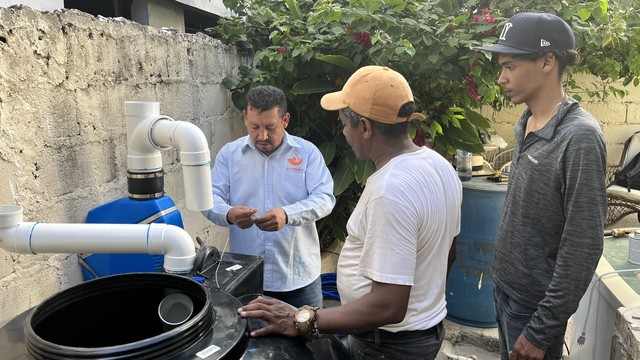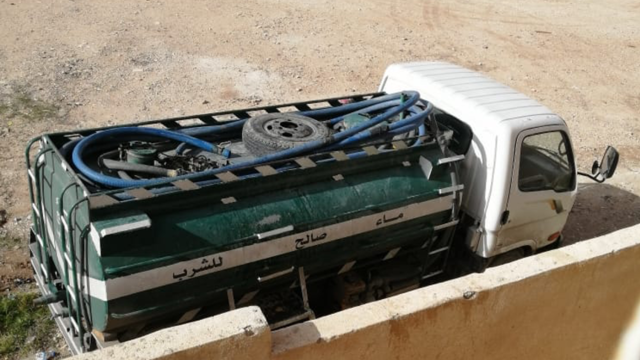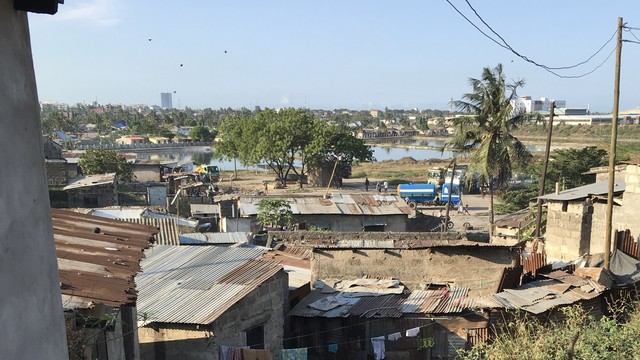Indigenous Peoples call for recognition of vital role in protecting mountain water towers
From 22-24 March 2023, 10,000 people gathered in New York for the UN Water Conference, hosted by the Netherlands and Tajikistan, to scale up action to address the water crisis and achieve Sustainable Development Goal 6 on clean water and sanitation.

Members of the Quechua community in the Potato Park in Peru gather in front of a camera to present live to the UN Water Conference (Photo: Enrique Granados, Asociación ANDES (Peru))
The International Network of Mountain Indigenous Peoples (INMIP), IIED and the Mountain Partnership secretariat organised a side event on ‘Protecting and restoring critical water related ecosystems in mountains: the role of Indigenous Peoples and biocultural territories’.
This was one of the few events that centred on the knowledge and solutions of Indigenous Peoples in a conference dominated by high-level officials, big corporations and NGOs.
Quechua communities in the Potato Park in Peru presented directly to the side event audience via Zoom from high altitude sacred lakes and rivers, in the Potato Park and the Chalakuy (barter) Park. These collectively-governed Indigenous biocultural territories in the high Andes of Peru play a vital role in protecting and restoring water resources and related ecosystems for the city of Cusco.
Mountains provide 60-80% of the world’s freshwater. Mountain Indigenous Peoples in Peru and across the globe protect water resources and related ecosystems – such as forests, wetlands, grasslands, lakes and streams – through cultural and spiritual values related to nature, sacred sites and customary water management systems.
But these ‘water towers’ and access to clean water are increasingly threatened by climate change, pollution (from mining, for example) and privatisation.
Quechua elders and women spoke passionately of their close relationship with water: “Water is the blood that flows through our bodies and through mountains and crops; it is not just for humans but for all our relations, including wildlife,” they said.
“We need to keep our respect for Mother Earth and Mother Water. Since before the Incas, people in these lands have always seen water as sacred. Since our ancestors we’ve practiced sowing and harvesting water.”
A young girl from the Chalakuy Park in Lares District read a poem that she wrote for the event: “Mother water we remember you on your day, you give life to our animals and plants, you walk in the clouds, from you is born the snow, rain and rivers, from you the whole world lives.”
The communities expressed concern about the impacts of climate change. In the Chalakuy Park: “The rains come very late, and this is affecting us”. In the Potato Park: “It has been very hard as we had a dry spell due to climate change. We have three lakes, but every year we worry about the level of water, as it is declining. This is very concerning as we depend on this water and so do downstream communities.”
In the Potato Park, water resources are managed and conserved through:
- Amunas, an ancestral water harvesting system that captures and regulates the volume of water in the upper part mountain during the rainy season and channels water to infiltration and storage areas in the subsoil
- Traditional small dams
- Creating rows for planting crops in a certain direction so that water is not wasted and soil is not eroded
- Looking after pasturelands that act as sponges, from the top of the mountain, and
- Using terraces to plant on slopes and keeping different plants at the margins of farmers’ fields to capture rain and manage risk.
For these Quechua communities in Peru, the most important rituals are water ceremonies, such as a traditional water festival on 20 May where they offer sacred coca leaves to the water and celebrate communion so their “relationship with water can be respectful and water can be happy”.
The Potato Park and Chalakuy Park communities called on governments and others to:
- Recognise and protect the critical role of Indigenous mountain peoples and biocultural territories in protecting water towers, ensure their active participation in decision making, and recognise their cultural and spiritual values connected to water and related ecosystems
- Implement more ambitious solutions for climate mitigation, and
- Halt the privatisation of water resources which threatens mountain communities that depend on communal water resources, and support customary water management systems that have proved critical to cope with drought in mountain communities globally.
The main outcome of the UN Water Conference is the Water Action Agenda, which consists of over 700 voluntary commitments by member states, banks, the private sector and NGOs.
Through its ‘Water Temples Initiative’, INMIP, which is a network of mountain communities in 13 countries in Latin America, Asia and Africa, has committed to establishing a global network of Indigenous biocultural territories to protect and restore mountain water ecosystems, with support from IIED. However, financial support is needed to implement this commitment.
Biocultural territories protect the sacred nature of water and conserve traditional water management systems - as well as agrobiodiversity, wildlife and ecosystems - for community health and wellbeing, livelihoods, food security and climate adaptation and mitigation, based on customary laws.
They provide a crucial tool for achieving several SDGs, as well as the 2030 Global Biodiversity targets (including Target 3), the Paris Agreement on climate change and the FAO Treaty on Plant Genetic Resources, while protecting the biocultural rights and self-determination of Indigenous Peoples.
Further information
- Summary of the side event: Protecting and restoring critical water-related ecosystems in mountains: the role of Indigenous Peoples and biocultural territories (PDF)
- Press release: Historic UN conference marks watershed moment to tackle global water crisis and ensure water-secure future (PDF)
- Advancing sustainable mountain development and protecting the “water towers” of the world, Mountain Partnership secretariat
- Traditional mountain landscapes: crucial for meeting biodiversity and climate targets, Krystyna Swiderska, Alejandro Argumedo, Eric Chavez, Chemuku Wekesa, Yiching Song (2022), IIED Briefing
- Biocultural heritage territories: key to halting biodiversity loss, Krystyna Swiderska, Alejandro Argumedo, Michel Pimbert (2020), IIED Briefing
- Indigenous Peoples' Declaration for the 2023 United Nations Water Conference (PDF)
- Biocultural heritage website
Contact
Krystyna Swiderska (krystyna.swiderska@iied.org), principal researcher, IIED's Natural Resources research group



